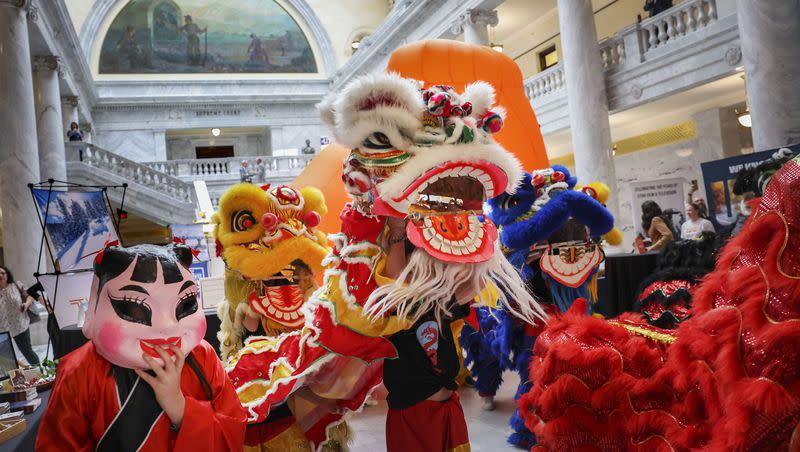How is Lunar New Year celebrated around the world?

Lunar New Year will be celebrated on Feb. 10 this year, launching the year of the dragon.
Here’s information on what Lunar New Year is and how it’s celebrated.
History of Lunar New Year
The Lunar New Year holiday is an annual tradition that has been celebrated for thousands of years. It marks the beginning of the new year on the Chinese calendar, per National Geographic.
The Chinese calendar was once known as the lunisolar calendar, because the moon and the sun determined the dates. A new month began when there was a new moon, according to National Geographic.
This year is the year of the dragon, which is one of the animals from the Chinese zodiac calendar. An animal is assigned to a year based on a “12-year cycle represented by 12 different animals, in this order: Rat, Ox, Tiger, Rabbit, Dragon, Snake, Horse, Goat, Monkey, Rooster, Dog and Pig,” per CNN.
According to National Geographic, the Lunar New Year festival is a two-week celebration that originated in China but has spread to other countries in Asia.
In China, Lunar New Year has been rebranded as the Spring Festival, but in other countries such as South Korea, Vietnam and Malaysia it is still called Lunar New Year.
Common traditions for Lunar New Year
Clean out the bad luck
One of the most important aspects of Lunar New Year festivities starts the week before Lunar New Year. That’s when participants clean their houses thoroughly. It is believed that taking this step will clear out all the bad luck that accumulated the previous year, per National Geographic.
Keep Nian away
Another important characteristic of Lunar New Year is the incorporation of the color red. According to CNN, there is a myth about a powerful creature called a Nian that wanted to destroy a village. While everyone evacuated, an old man passing through refused to leave the village. When everyone came back, they were shocked to see the old man and the village unscathed.
In the myth, the old man claims that it was his red clothes, firecrackers and decorative red banners that kept Nian away. And so, the tradition of wearing something red, lighting firecrackers and decorating your house in red banners began. It continues to this day.
Red is also associated with joy and good luck in Chinese culture, so communities can often be found using red paint and red decorations, per National Geographic.
Get ready for chunyun, aka the biggest human migration ever
As Lunar New Year has spread across the globe, so has its themes of family reunion and hope.
Chunyun, meaning spring migration, is when billions of people travel back to their hometowns and other locations to celebrate Lunar New Year, per National Geographic. It has caused a lot of transportation problems in the past.
In 2016, more than 100,000 people were stuck at a train station in China due to chunyun, per Smithsonian Magazine.
Red packets full of money
Depending on which country you’re celebrating in, the red packets of money that go along with Lunar New Year festivities will be called by different names. But the concept is the same.
CNN explains that the red packets are given by married couples to children and single adults. They believe that this will protect the receiver from an evil spirit known as a sui.
The variations of Lunar New Year
In Malaysia
Malaysians participate in what is known as yeesang, meaning prosperity toss, per CNN, when everyone tosses a specific piece of food up into the air. Each piece of food has a specific meaning, such as white radishes representing growth and fortune.
In Korea
Koreans prepare what is known as sliced rice cake soup (tteokguk), symbolizing the importance of starting the new year with a clean mind and body, per History.
They also have a tradition of giving money in packets, but instead of giving it to unmarried people, they give money to their elders in a special white envelope. It is a time for them to honor their ancestors, according to National Geographic.
In Vietnam
Flowers play an important role in the Vietnamese Lunar New Year. Instead of using red banners and decorations like the Chinese, the Vietnamese instead use a variety of flowers like peach blossoms, orchids or even a kumquat tree to decorate their homes, per History.
The Vietnamese will also honor their ancestors by preparing a special dish called a five-fruit platter and sharing it with guests.
In the United States
San Francisco hosts the largest Chinese New Year parade outside of China. Known as the Chinese New Year Festival and Parade, it claims to be one of the only night-illuminated parades in North America.
The tradition started in the 1860s when immigrants from China wanted to share their culture with Americans and now has up to 3 million spectators from around the globe.

